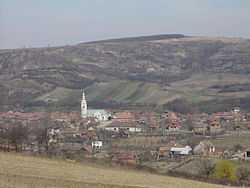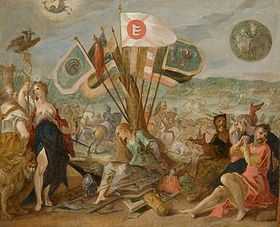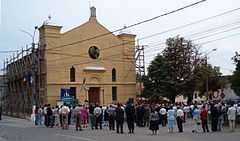Sălaj County
| Sălaj County Județul Sălaj | ||
|---|---|---|
| County | ||
| ||
 | ||
| Country | Romania | |
| Development region | Nord-Vest | |
| Historical region | Crișana, Transylvania | |
| Capital | Zalău | |
| Area | ||
| • Total | 3,864 km2 (1,492 sq mi) | |
| Area rank | 38th | |
| Population (2011) | ||
| • Total | 224,384 | |
| • Rank | 39th | |
| • Density | 58/km2 (150/sq mi) | |
| Telephone code | (+40) 260 or (+40) 360[1] | |
| ISO 3166 code | RO-SJ | |
| Website |
County Council Prefecture | |
Sălaj (Romanian pronunciation: [səˈlaʒ]) (also known as Land of Silvania, silva, -ae means "forest") is a county (județ) of Romania, in the historical regions of Crișana and Transylvania, with the capital city at Zalău.
Name
In Hungarian, it is known as Szilágy megye, in Slovak as Salašská župa, and in German as Kreis Zillenmarkt. The county is named after the Sălaj River, which gets its name from Hungarian Szilágy "elm creek", composed from szil, "elm" and ágy "riverbed".[2]
Geography
Sălaj County has a predominantly hilly relief - the Someș Plateau and the piedmont hills of Silvania - as well as mountainous hills - the northern ramifications of Apuseni Mountains (Meseș and Plopiș Mountains). The district stretches over 3,864 km², more than half of them have an agricultural destination (tillable land, meadows, hay-fields, vineyards and orchards). The rest of the surface is covered with forests and other wood vegetation, rivers, ponds etc.
Hydrography
The main characteristic of the hydrographic network of Sălaj County is the relative uniformity of the distribution of rivers throughout the territory, with a very low presence of natural lakes network, but with the advent of increasingly often artificial lakes. Someș, Crasna, Barcău, Almaș, Agrij and Sălaj are the main rivers in the county. Located in Crasna basin, the Vârșolț Reservoir (652 ha) is the drinking water source for the towns of Zalău and Șimleu Silvaniei.[3] Water covers 57.8 km2, representing 1.5% of the total area of the county.[4]
Neighbours
Sălaj County borders on Satu Mare and Maramureș counties to the north, Bihor County to the west and southwest and Cluj County to the southwest.
Climate
As for climate, Salaj county is under the influence of masses of air coming from West having a moderate continental climate. The average annual temperature varies between 6°C and 9°C, depending on the zone while the highest temperature, in July, varies between 35°C and 42°C. Rainfalls quantitatively decrease towards the west where 700-800 ml/sq.m were recorded.
Demographics

| Historical population | ||
|---|---|---|
| Year | Pop. | ±% |
| 1880 | 159,872 | — |
| 1890 | 180,145 | +12.7% |
| 1900 | 193,996 | +7.7% |
| 1910 | 230,140 | +18.6% |
| 1930 | 343,347 | +49.2% |
| 1948 | 262,580 | −23.5% |
| 1956 | 271,989 | +3.6% |
| 1966 | 263,103 | −3.3% |
| 1977 | 264,569 | +0.6% |
| 1989 | 268,776 | +1.6% |
| 1992 | 266,308 | −0.9% |
| 2002 | 248,015 | −6.9% |
| 2011 | 224,384 | −9.5% |
| Source: National Institute of Statistics, "Population censuses of 1948, 1956, 1966, 1977, 1992 and 2002" | ||
In 2002, Sălaj County had a population of 248,015 and the population density was 64/km². Majority of the population lived in rural area (60,3%) and 39,7% lived in four cities: Zalău, Șimleu Silvaniei, Jibou, and Cehu Silvaniei.
- Romanians - 71.6% (or 176,671) [5]
- Hungarians - 23.04% (or 57,167)
- Roma - 5.05% (or 12,544)
- Slovaks - 0.55% (or 1,366)
- Other or undeclared ethnicity - 0.1%
According to 2011 census,[6] Sălaj County had a population of 224,384 and the population density was 58/km². Majority of the population lived in rural area (60,7%) and 39,3% lived in four cities: Zalău, Șimleu Silvaniei, Jibou, and Cehu Silvaniei.
In 2011, the ethnic composition was as follows:[7]
- Romanians - 69.05% (or 148,396)
- Hungarians - 23.35% (or 50,177)
- Roma - 6.98% (or 15,004)
- Slovaks - 0.5% (or 1,229)
A negative natural growth rate and an average life span of 71.04 years are characteristic for the social and demographic situation of the district. The social and urban dimension of the district is characterized by a degree of urbanization of more than 40% and by the number of dwelling places per 1,000 inhabitants, which is higher than the average on a national level.[8]
Tourism

The main tourist attractions in the county are:
- Porolissum
- Spa resorts: Bizușa-Băi, Jibou, Boghiș
- Wooden churches (up to 77, dating from the 15th–18th centuries): Fildu de Sus, Poarta Sălajului, Baica, Dragu, Sânmihaiu Almașului, Fodora, Răstoci, Domnin, Bulgari
- Strâmba Monastic Ensemble, Păduriș
- Bic Monastery
- Valcău Citadel (1319), Sub Cetate
- Báthory Citadel (1532), Șimleu Silvaniei
- Aranyos Citadel (1314), Cheud
- Dezső Citadel (1278), Almașu
- Reserves and natural monuments: Lapiș Forest, Racâș Daffodils Glade, Garden of Ogres, Limestones of Rona, Barcău Springs
- Jibou Botanical Garden and Wesselényi Castle
- Ligia Bodea Folk Art Museum, Iaz – hosts one of the largest private ethnographic collections in Romania[9]
Economy
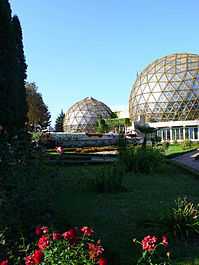
The predominant industries in the county are:
- Machine and automotive components
- Food
- Textiles
- Wood, furniture and paper
History

Paintings dating back 12,000 years were discovered on the walls of a cave in Cuciulat, a settlement on the banks of the Someş River. They are the oldest paintings of the kind in this part of Europe. The oldest solid gold treasury ever unearthed in Romania, weighing 780 gr. and belonging to the Neolithic, was found in Sălaj at Moigrad.
Lying in the north-western part of Romania, at the crossing between the Western and Eastern Carpathians, Sălaj county has been known since ancient times as Țara Silvaniei, that is the Land of the Forests. Zalău was known as a market town as early as the 14th century and mentioned in a document as a town in 1473.
Under Austria Hungary

Sălaj County (Hungarian: Szilágy) was formed in 1876, when the counties Kraszna (its center was Valkóváralja at first, later Szilágysomlyó) and Közép-Szolnok (Its center was Zilah) were united. Its territory is for a large part the same as that of the present Romanian county Sălaj County. Its area was 3815 km² around 1910. The capital of the county was Zilah (present-day Zalău in Romania).
In 1918 (confirmed by the Paris Peace Conference 1919-1920), the county became part of Romania. It was occupied by Hungary between 1940-1944 during World War II. Most of it is now part of the Romanian county Sălaj County, except some areas in the north-west (presently in Satu Mare county) and north-east (presently in Maramureș county).
During the Kingdom of Romania, Sălaj County was divided in 8 plăși (Plasa Carei, Plasa Cehu Silvaniei, Plasa Crasna, Plasa Jibou, Plasa Șimleu Silvaniei, Plasa Tășnad, Plasa Valea lui Mihai and Plasa Zălau.
Politics
2012 elections
The Sălaj County Council, elected in the 2012 local government elections, with the following party composition:[10]
| Party | Seats | 2012 Sălaj County Council | ||||||||||||||
|---|---|---|---|---|---|---|---|---|---|---|---|---|---|---|---|---|
| Social Liberal Union | 14 | |||||||||||||||
| Democratic Union of Hungarians in Romania | 7 | |||||||||||||||
| Democratic Liberal Party | 6 | |||||||||||||||
| People's Party – Dan Diaconescu | 3 | |||||||||||||||
Notable residents
.jpg)
- Stephen Báthory (1533–86), Prince of Transylvania (1571–75) and King of Poland (1575–86)
- Miklós Wesselényi (1796–1850), statesman and leader of the upper house of the Diet of Hungary
- Simion Bărnuțiu (1808–64), politician, historian, philosopher and one of the main organizers of the 1848 Revolution in Transylvania
- Ioan Lobonțiu (d. 1870), Greek Catholic priest, dean and 1848 revolutionary
- Alexandru Papiu-Ilarian (1827–77), lawyer, historian, linguist, one of the main organizers of the 1848 Revolution in Transylvania and member of the Romanian Academy
- Gheorghe Pop de Băsești (1835–1919), President of the Romanian National Party and prominent figure of the 1918 unification of Transylvania with Romania
- Alimpiu Barboloviciu (1843–1914), Greek Catholic dean, vicar, publicist and President of ASTRA
- Petri Mór (1863–1945), writer and teacher
- Ioan Taloș (d. 1946), Greek Catholic priest, dean and deputy
- Iuliu Maniu (1873–1953), Prime Minister of Romania, Minister of National Defence, Minister of Finance, President of the National Peasants' Party and honorary member of the Romanian Academy
- Endre Ady (1877–1919), poet
- Béla Kun (1886–1938), communist politician and leader of the 1919 Bolshevik Revolution in Hungary
- Joe Pasternak (1901–91), film director
- Corneliu Coposu (1914–1995), politician, President of the Christian Democratic National Peasants' Party and political prisoner
- Alexander Ratiu (1916–2002), Greek Catholic priest, author and political prisoner
- Alexandru Dragomir (1916–2002), philosopher
- Augustin Deac (1928–2004), author and historian
- Alexandru Koller (b. 1953), footballer and businessman
Administrative divisions
Sălaj County has 1 municipality, 3 towns and 57 communes; subdivided into 281 villages
Municipalities
- Zalău - capital city; population: 56,202 (October 30, 2011)
Towns
- Cehu Silvaniei - population: 7,214 (October 30, 2011)
- Jibou - population: 10,407 (October 30, 2011)
- Șimleu Silvaniei - population: 14,436 (October 30, 2011)
Communes
- Agrij
- Almașu
- Băbeni
- Bălan
- Bănișor
- Benesat
- Bobota
- Bocșa
- Boghiș
- Buciumi
- Camăr
- Carastelec
- Chieșd
- Cizer
- Coșeiu
- Crasna
- Creaca
- Crişeni
- Cristolț
- Cuzăplac
- Dobrin
- Dragu
- Fildu de Jos
- Gâlgău
- Gârbou
- Halmășd
- Hereclean
- Hida
- Horoatu Crasnei
- Ileanda
- Ip
- Letca
- Lozna
- Măeriște
- Marca
- Meseșenii de Jos
- Mirșid
- Năpradea
- Nușfalău
- Pericei
- Plopiș
- Poiana Blenchii
- Românași
- Rus
- Sălățig
- Sâg
- Sânmihaiu Almașului
- Someș-Odorhei
- Surduc
- Șamșud
- Sărmășag
- Șimișna
- Treznea
- Valcău de Jos
- Vârșolț
- Zalha
- Zimbor
Works
- Petri Mór, Szilágy vármegye monographiája [Sălaj County Monography] (I-VI, Budapest, 1901–1904).
- János Kovács Kuruc, Zilah vallási életéről, In: Limes, 2000, 3, nr. 1-2, p. 138-143.
- Éva Lakóné Hegyi; Wagner, Ernő. A zilahi kalandosok, In: EM, 2001, 63, nr. 1-2, p. 30-41.
- Florin Mirghesiu, Modernitatea Zalăului. In: AMPZ, 2001, 2, nr. 4, p. 11-19.
- Moroti, Elisabeta. Scurtă privire istorică asupra dezvoltării economice a orașului Zalău, In: AMPZ, 2001, 2, nr. 4, p. 36-39.
- Municipiul Zalău. Prezentare. In: AMPZ, 2002, 3, nr. 7-8, p. 154-161.
- Elena Muscă, Meșteșugari zălăuani și locul lor în structurile administrației publice locale, In: AMP, 2003, 25, p. 325-332.
- L. Nicoară; Puşcaș, Angelica. Rolul municipiului Zalău în zona de contact dintre depresiunea Transilvaniei și Dealurile de Vest, In: Studia geogr., 1999, 44, nr. 1, p. 99-112.
Gallery
-

Sălaj County (Hungarian: Szilágy) coat of arms during the Hungarian Kingdom
-

Interbelic Sălaj County CoA
-

Sălaj County CoA in Communist Romania
-

Coat of arms since 1990s
-

Battle of Guruslău, 1601
-

Szilágy County (Romanian: Sălaj) between 1876 and World War I
-
A monument in Treznea, Sălaj County
-

1715 Census
-
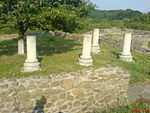
A Roman house in Porolissum
-

Sălaj County
-

Sălaj County within Transylvania
-

A religious ceremony in Totoreni, Sălaj County
-

Tusa, Sălaj County
-

City Hall of Zalău
-

An archaeological report in Sălaj County
-

Former Greek Catholic Church was built in 1936
-

A district in Zalău
-

A district in Zalău
-

The main square in Zalău
-

The industrial district in Zalău
References
| Wikimedia Commons has media related to Sălaj County. |
- ↑ The number used depends on the numbering system employed by the phone companies on the market.
- ↑ Iordan, Iorgu (1963). Toponimia romînească. Bucharest: Editura Academiei Republicii Populare Romîne. p. 104. OCLC 460710897.
- ↑ "Vârșolț Reservoir", Wikimapia.org
- ↑ "Geographical location of Sălaj County", Chamber of Commerce and Industry Sălaj
- ↑ National Institute of Statistics, "Populația după etnie"
- ↑
- ↑ Recensamantul Populatiei si Locuintelor 2011: Populația stabilă după etnie – județe, municipii, orașe, comune
- ↑ "Sălaj – Dimension and expansion", Sălaj County Council
- ↑ Matyas, Mirel (26 February 2013). "Ați fost vreodată în Sălaj?". cluj.travel (in Romanian).
- ↑ http://www.sj33.ro/articole/310/rezultatele-alegerilor-locale-2012-in-judetul-salaj/
External links
- (Romanian) http://www.cjsj.ro/index.php
- (Romanian) http://www.salaj.insse.ro/main.php
- (Romanian) and (English) http://www.insse.ro/cms/files/pdf/ro/cap2.pdf
- (English) http://circa.europa.eu/irc/dsis/regportraits/info/data/ro066_geo.htm
- (Romanian) http://www.flickr.com/photos/mipepitoida/2869382695/
| ||||||||

